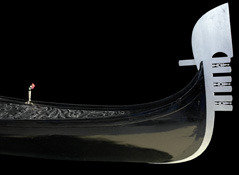Three Exhibitions
dal 8/12/2011 al 8/4/2012
Segnalato da
8/12/2011
Three Exhibitions
Museen Dahlem, Berlin
After two years of extensive renovations, the Museum of European Cultures is all set to reopen its doors in its Dahlem home with three new show: Explorations in Europe - Visual Studies in the 19th Century, Cultural Contacts - Life in Europe, Cultural Change under the Influence of the Europeans - The Eastern Woodlands.

Explorations in Europe.
Visual Studies in the 19th Century
After two years of extensive renovations, the Museum of European Cultures is all set to reopen its doors on 9 December 2011 in its Dahlem home, in the building designed by Bruno Paul. The temporary exhibition 'Explorations in Europe - Visual Studies in the 19th Century' picks up on the theme of cultural encounters featured in the newly opened permanent exhibition, by looking at two specific examples.
In the 19th century, travelling artists and scientists set out to become acquainted with and explore other cultures. The things they saw were captured in their pictures and photographs. They also had architectural models created to scale of the constructions they found along the way. One impressive example of such an expedition is highlighted here in the oil paintings and miniature buildings by the Berlin painter Wilhelm Kiesewetter, who spent 14 years in the mid-19th century travelling extensively through North and Eastern Europe. At this point in time photography was still in its infancy, but developed rapidly, with the result that scientific photography soon replaced detailed drawings and pictures. And it was in this area in particular that scientists such as Rudolf Virchow from the Berliner Gesellschaft für Ethnologie, Anthropologie und Urgeschichte (a society for ethnology, anthropology and prehistory), left their mark.
Presented by:
Museum of European Cultures
----
Cultural Contacts.
Life in Europe
Spread over 700 square metres, the permanent exhibition 'Cultural Contacts. Life in Europe' is the first ever display of a cross-section of all the museum's diverse collections. It examines discussions on social movements and social boundaries. The mobility, physical and social, of people within Europe and to Europe sets off a chain of cultural interaction and intermingling that may give rise to the development of global cultures, while at the same time raising questions of belonging and the identity of individuals and whole groups. As a result of such globalization individuals may feel 'lost' and yearn for what is familiar to them: their home, their home town, a particular region or their country.
Do Europe's cultural commonalities play a role in this process? The permanent exhibition highlights a few examples of such shared cultural affinities - in part by way of some extraordinary objects. For instance, a luxurious gondola from Venice, dating from 1910, encapsulates several themes at once: trade, travel, visual media, migration, specific cultural localities and piety.
----
Cultural Change under the Influence of the Europeans.
The Eastern Woodlands
The new room dedicated to the theme of cultural change wrought by European influence in the eastern woodlands is closely tied in with the first part of the permanent exhibition on the 'Native Americans of North America.'
The Ethnological Museum's collection of artefacts from North America's eastern woodlands ranks as one of the oldest and richest to stem from this region. Of particular note are articles of clothing made from European woollen fabrics, which were adorned by Native American women with elaborate silk ribbons and which were first brought to Berlin in the 1840s. A further example of cultural change is the production of souvenirs around 1850, designed for tourists to Niagara Falls and the surrounding areas, whereby traditional Native American Indian elements were fused with the European visitors' desire for local mementos.
At the heart of this exhibition is the synthesis of European materials, such as fabrics, glass beads and metal goods, with traditional Indian craft design that ultimately led to new cultural forms.
Presented by:
Ethnological Museum
Image: Original Venetian gondola, ca. 700 kg, 11 m long, constructed around 1910
© National Museums in Berlin; Museum of European Cultures; photo: Claudia Obrocki
Museen Dahlem
Lansstraße 8 - 14195 Berlin
Opening Hours Mon closed
Tue, Wed, Thu, Fri 10:00 a.m. - 6:00 p.m.
Sat 11:00 a.m. - 6:00 p.m. Sun 11:00 a.m. - 6:00 p.m.



